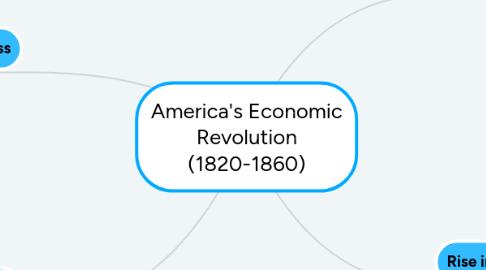
1. Rise of Business
1.1. Corporations
1.1.1. Corporation laws that limited the rights of that type of business were removed. Corporations now could obtain a charter for their business just by paying a fee
1.2. Labor Unions
1.2.1. Workers' rights were almost nonexistent during this time. Even Children and Women had to experience awful working conditions and low wages. The first trade unions formed although they didn't accomplish much
1.3. Technological Growth
1.3.1. There was a rise in technology in several industries. This lead to the extreme growth of many areas in business
2. Living in America
2.1. Rural Living
2.1.1. Less human interaction outside of family. Main source of income was farming. Used things that they had in common with other people to form relationships. Many would move to urban areas after the farming industry grew too big
2.2. Urban Living
2.2.1. Much more human interaction. There was a huge presence of factories and corporations. More poverty but a larger range to make an income
3. Immigration Growth
3.1. Improvement in Public Health
3.1.1. Diseases declined along with an increased birth rate which caused immigration and the population to grow
3.2. Nativism
3.2.1. The growth in immigration led a rise of nativism, a feeling that gave Natives superiority over foreigners
3.3. Know Nothing Party
3.3.1. A party of nativists that wanted foreigners and Catholics to be banned from voting and holding office
4. Rise in Technology
4.1. Telegraphs
4.1.1. First form of direct communication through technology. Would link the country like never before
4.2. New Inventions
4.2.1. The greatest invention during this time was the cast-iron stove. Would replace fireplaces as the main tool for cooking. Changed American diets for better
4.3. Innovations in Farming
4.3.1. Some of the new agricultural machines were efficient grain drills, harrows, mowers, hay rakes, the cast-iron plow, automatic reapers, and the thresher
4.4. Transportation
4.4.1. Although not as sophisticated as it would be, railroads were beginning to be planned out and built. Along with this, man-made waterways called canals were built. Both forms of transportation would help shipping and transporting goods greatly
